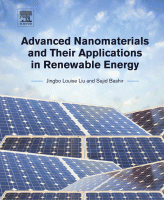Browse content
Table of contents
Actions for selected chapters
- Full text access
- Book chapterAbstract only
Chapter 1 - Nanomaterials and Their Application
Pages 1-50 - Book chapterAbstract only
Chapter 2 - Overviews of Synthesis of Nanomaterials
Pages 51-115 - Book chapterAbstract only
Chapter 3 - Nanocharacterization
Pages 117-180 - Book chapterAbstract only
Chapter 4 - Sustainable Energy Application: Nanomaterials Applied in Solar Cells
Pages 181-231 - Book chapterAbstract only
Chapter 5 - Sustainable Energy Application: Fuel Cells
Pages 233-296 - Book chapterAbstract only
Chapter 6 - Porous Materials to Store Clear Energy Gases
Pages 297-327 - Book chapterAbstract only
Chapter 7 - Carbon Capture and Storage
Pages 329-366 - Book chapterAbstract only
Chapter 8 - Nanosafety: Exposure, Measurement, and Toxicology
Pages 367-421 - Book chapterNo access
Chapter 9 - Conclusions/Postlog
Pages 423-424 - Book chapterNo access
Index
Pages 425-438
About the book
Description
Advanced Nanomaterials and Their Applications in Renewable Energy presents timely topics related to nanomaterials' feasible synthesis and characterization, and their application in the energy fields. In addition, the book provides insights and scientific discoveries in toxicity study, with information that is easily understood by a wide audience.
Advanced energy materials are important in designing materials that have greater physical, electronic, and optical properties. This book emphasizes the fundamental physics and chemistry underlying the techniques used to develop solar and fuel cells with high charge densities and energy conversion efficiencies.
New analytical techniques (synchronous X-ray) which probe the interactions of particles and radiation with matter are also explored, making this book an invaluable reference for practitioners and those interested in the science.
Advanced Nanomaterials and Their Applications in Renewable Energy presents timely topics related to nanomaterials' feasible synthesis and characterization, and their application in the energy fields. In addition, the book provides insights and scientific discoveries in toxicity study, with information that is easily understood by a wide audience.
Advanced energy materials are important in designing materials that have greater physical, electronic, and optical properties. This book emphasizes the fundamental physics and chemistry underlying the techniques used to develop solar and fuel cells with high charge densities and energy conversion efficiencies.
New analytical techniques (synchronous X-ray) which probe the interactions of particles and radiation with matter are also explored, making this book an invaluable reference for practitioners and those interested in the science.
Key Features
- Provides a comprehensive review of solar energy, fuel cells, and gas storage from 2010 to the present
- Reviews feasible synthesis and modern analytical techniques used in alternative energy
- Explores examples of research in alternative energy, including current assessments of nanomaterials and safety
- Contains a glossary of terms, units, and historical benchmarks
- Presents a useful guide that will bring readers up to speed on historical developments in alternative fuel cells
- Provides a comprehensive review of solar energy, fuel cells, and gas storage from 2010 to the present
- Reviews feasible synthesis and modern analytical techniques used in alternative energy
- Explores examples of research in alternative energy, including current assessments of nanomaterials and safety
- Contains a glossary of terms, units, and historical benchmarks
- Presents a useful guide that will bring readers up to speed on historical developments in alternative fuel cells
Details
ISBN
978-0-12-801528-5
Language
English
Published
2015
Copyright
Copyright © 2015 Elsevier Inc. All rights reserved.
Imprint
Elsevier Science
